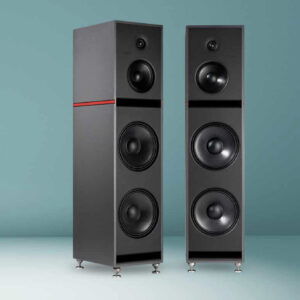
A true story: at the Consumer Electronics Show (CES) 2008, Definitive Technology rolled out its Mythos STS Super Tower loudspeaker ($2998/pair), a tall, slim speaker with an self-powered subwoofer fitted within its svelte cabinet. The STS was intended as a smaller and lower-priced version of the firm’s critically acclaimed Mythos ST (see my review in Playback Issue 2). As I listened to the STS in Definitive’s demonstration suite, it struck me as being one of those rare creations where the whole is greater than the sum of the parts—a speaker that recalibrates our notion of what products its price can do.
A few minutes later I visited the suite of a boutique speaker maker who was introducing new tower models roughly the height of the STS, but that sold for (gulp!) about $20,000/pair. As I listened to the $20k towers, I noted a few performance areas where they were better than the STS, but many areas where they glaringly were not. A colleague who was touring the show with me leaned over and whispered, “Is it my imagination, or were those $3000 Definitive speakers better than these expensive towers overall?” My answer: No, it’s not your imagination, and yes, the Mythos STS invites comparison to far more costly products.
FEATURES
The Mythos STS’s pencil-slim enclosure is made of extruded aluminum and divided into two chambers. The top chamber houses a midrangetweeter- midrange D’Appolito driver array, while the lower chamber houses a racetrack-shaped, carbon fiber woofer, two oblong passive radiators and a 300-watt bass amplifier. The STS features the same tweeter used in the ST, while its midrange driver, woofer, and passive radiators are basically downsized versions of the ST’s drivers.
The sidewalls of the STS enclosures are gently rounded to help fight unwanted internal resonance, and they give the speaker a parabolic shape when viewed from above. The cabinets are polished to a silky, satin sheen, and offered in either anodized black or silver. Finally, “rock solid” mounting bases made of polished granite give the speakers a firm foundation and a touch of understated elegance.
CHARTING THE DIFFERENCES
As the comparison table below shows, the STS is smaller than the ST in every dimension, though not by a huge margin. But in terms of creating first impressions, those small differences really add up, so that most viewers say that the STS seems significantly more compact than its bigger sibling.
PERFORMANCE/SONIC CHARACTER
Much like the original ST, the Mythos STS exhibits four defining sonic characteristics: richness of detail, lively dynamics, smooth and neutral tonal balance, and terrific three-dimensionality. In particular, listeners were impressed with the huge, spacious soundstages the STS creates (see Illustration 1), and by the pinpoint precision of its imaging (see Illustration 2). Together these qualities make the STS one of the benchmark speakers in its class.
But while the STS sounds similar to the ST, there are several differences. First, the midrange of the STS sounds just slightly less full-bodied and open than that of the ST. Second, the STS’s dynamic capabilities are slightly less expansive than the ST’s—something you might not notice if you listen in small-to-mid-sized rooms, but that becomes apparent if you push the STS really hard in larger rooms. Finally, the STS’s bass is a little leaner and maybe a touch less extended than the ST’s. These differences are quite subtle, so that you might not notice them unless you have the opportunity, as we did, to compare the STS and ST sideby- side. But all in all, the STS preserves much of the “feel” and overall excellence of the ST, and in a smaller, less expensive package. Stated simply, the STS is one of the most capable speakers $3000 can buy.
SELF-POWERED WOOFERS: MYTHOS STS’S SECRET WEAPON
The Mythos STS’s self-powered woofer system is a “gift that keeps on giving,” and here’s why. With conventional tower-type speakers your amplifier must do all the heavy lifting, handling everything from the highest highs to the lowest lows— with bass notes soaking up the lion’s share of the power. But the Mythos STS is different because its built-in 300-watt bass amp handles the demanding bass frequencies, freeing your amplifier to power just the midrange/tweeter section of the speaker, which is easy to drive. So the STS helps in two ways: first by delivering deep, powerful, richly detailed bass, but also by taking a load off your amp so that it can sound better (or more “relaxed”) than it otherwise might.
MUSICAL (AND OTHER) EXAMPLES
I conducted most of my listening tests with musical material, using just a stereo pair of Mythos STS speakers However, I also plugged the speakers into Playback’s reference home theater system, which is based on the bigger Mythos ST’s, so I could check out the STS as a home theater platform, as well.
The slender STS makes a fine speaker upon which to base a surround system, in large part because it offers such a pleasing combination of power and finesse. You can hear both qualities in action in Chapter 17 of Harry Potter and the Order of the Phoenix, where Harry envisions that he is Nagini the snake slithering through the corridors of the Ministry of Magic to attack Arthur Weasley.
As the snake moved down the hallway, the STS delineated the eerie, whisper-like sound of its scaly body traversing the black tile floor while simultaneously reproducing the loud, low bass shudder of heartbeat-like sound effects signaling the reptile’s murderous intent. It’s this ability to handle subtle textural details while flexing its muscles that sets the STS apart. What’s more, the STS pretty much obviates the need for supplementary subwoofers (though for larger rooms, you might want to step up to the bigger, more potent ST). Music playback, however, is arguably the STS’s true forte, and here’s why. While certain speakers in the $3000/pair price range may do a few things better than the STS does, none offers a better-balanced or more complete overall package of sonic virtues.
Want details and finesse? Just listen to Marshal Royal and Joe Wilder trade solos in “Mood Indigo” from Mostly Ellington [Blueport/Nuforce], and you’ll hear the STS reproduce a cornucopia of subtle reed/mouthpiece noises, fingering sounds, and even moments when the performers breathe between phrases—all of which help the recording sound real.
Want lifelike dynamics? Check out “Moten Swing” from Clark Terry’s The Chicago Section 1995-96 [Reference Recordings] through the STS and prepare to be—quite literally— blown away by the big, bold, brassy horn section volume swells you’ll hear. Want imaging and soundstaging on a grand orchestral scale? Put on the Järvi/Cincinnati recording of “Marche au supplice” (March to the Scaffold) from Berlioz’s Symphonie fantastique [Telarc, SACD], and listen to the STS present the rich, layered sound of the orchestra as it expands to fill the stage and then reverberates within the recording venue. Few other speakers at this price can do so many things so well.






















